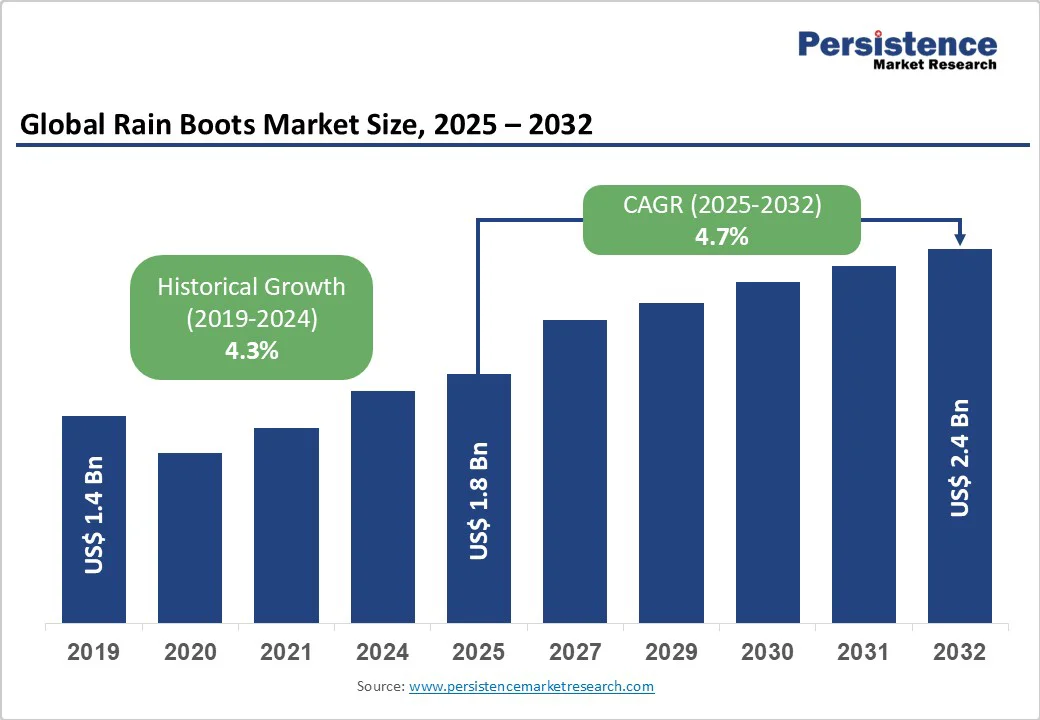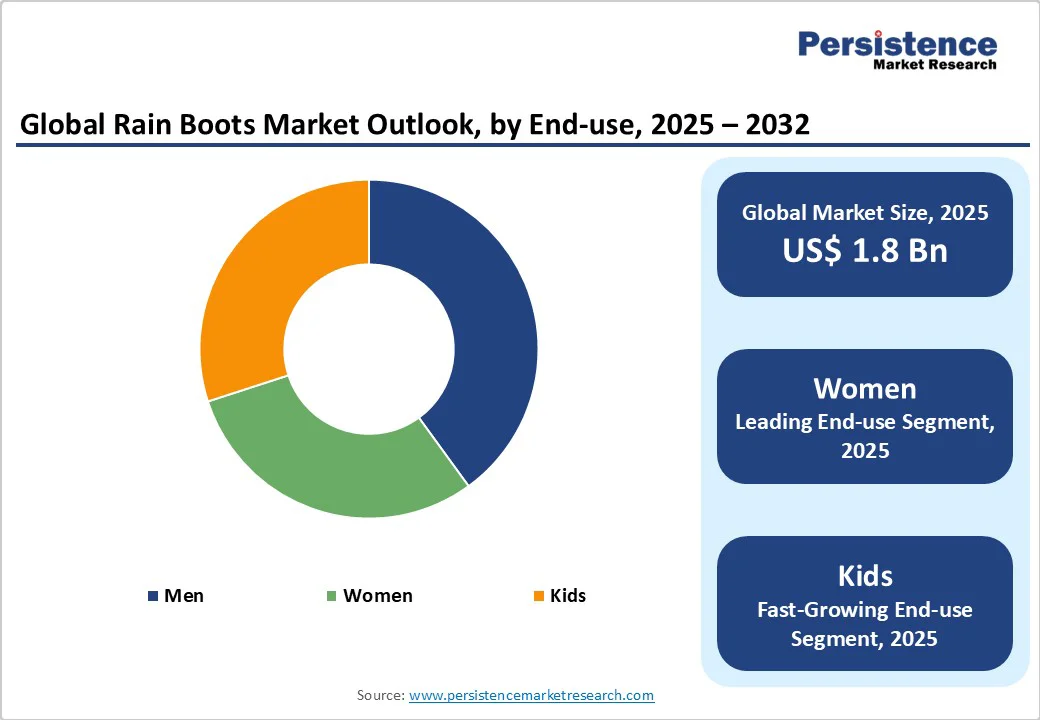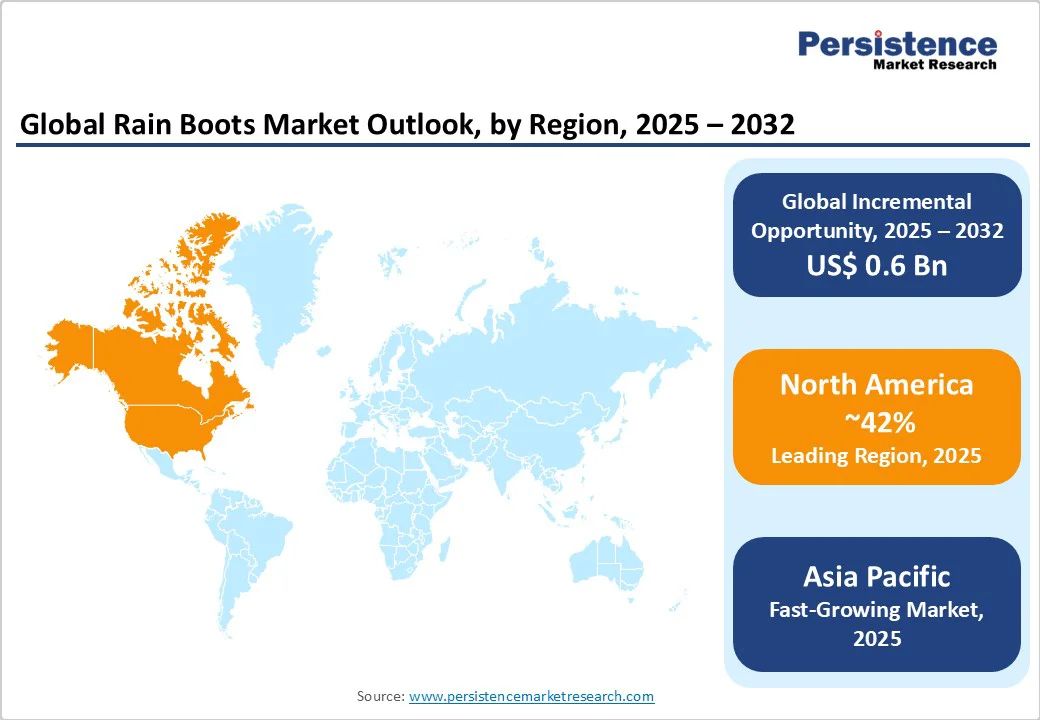ID: PMRREP33831| 176 Pages | 23 Oct 2025 | Format: PDF, Excel, PPT* | Consumer Goods

The global rain boots market size is likely to be valued US$ 1.8 Bn in 2025, estimated to reach US$ 2.4 Bn by 2032 growing at a CAGR of 4.7% during the forecast period from 2025 to 2032.
The market is experiencing robust growth driven by the increasing prevalence of wet weather conditions, rising consumer preference for stylish and functional footwear, and advancements in material technologies. The need for durable and waterproof footwear, particularly in regions with high rainfall, has significantly boosted the adoption of waterproof boots across various demographics.
The market is further propelled by innovations in synthetic rubber and eco-friendly materials, catering to consumer preferences for sustainable and comfortable options. The rise in outdoor activities and the growing fashion trend of rubber boots as everyday wear is a key growth factor.
| Global Market Attribute | Key Insights |
|---|---|
| Rain Boots Market Size (2025E) | US$ 1.8 Bn |
| Market Value Forecast (2032F) | US$ 2.4 Bn |
| Projected Growth (CAGR 2025 to 2032) | 4.7% |
| Historical Market Growth (CAGR 2019 to 2024) | 4.3% |

The increasing prevalence of wet weather conditions globally is a primary driver of the Rain Boots Market. According to meteorological data, regions with high rainfall create a substantial demand for waterproof footwear.
This widespread need creates a market for effective and stylish waterproof boots. Rubber boots offer protection from water and mud, typically providing comfort during rainy seasons, compared to regular footwear, which can become damaged. This is particularly critical for individuals in urban areas with frequent rain.
The rise in outdoor activities has further accelerated market growth. For instance, rubber boots from companies such as Hunter Boot Limited have gained traction due to their proven durability in various conditions. Additionally, the rise in fashion trends has boosted consumer access, further driving market expansion.
The rise in demand for functional delivery systems, coupled with innovations in synthetic materials, continues to propel the market forward, particularly in developed regions with advanced retail systems.
The high costs associated with the development and material sourcing of waterproof boots pose a significant restraint on market growth. Developing rubber boots requires advanced materials, rigorous testing, and specialized production to ensure waterproofing and durability. These processes involve substantial financial investment, often exceeding expectations, which can be a barrier for smaller companies and startups entering the market.
Additionally, regulatory bodies impose stringent requirements for product approval, including extensive safety and quality testing. Compliance with these standards, along with the need for specialized manufacturing facilities, increases overall costs and extends development timelines.
For instance, the approval process for new synthetic rubber rain boots can take several years, with costs escalating due to multiple phases of testing and post-market surveillance requirements. Smaller firms often struggle to meet these financial demands, limiting their ability to compete with established players such as Hunter Boot Limited and Puma SE.
Furthermore, the complexity of integrating advanced materials, such as eco-friendly synthetics, adds to production costs, which can deter innovation and slow market expansion, particularly in cost-sensitive regions.
Advancements in eco-friendly and fashionable designs present significant growth opportunities for the Rain Boots Market. Eco-friendly waterproof boots reduce environmental impact, making them a preferred choice for consumers concerned with sustainability.
These designs align with growing consumer demand for greener options. Additionally, fashionable designs that integrate style with functionality offer enhanced appeal by targeting multiple consumer segments, providing versatile and attractive footwear.
For example, companies such as Kamik and Bata Limited are investing in R&D to develop eco-friendly rain boots that combine natural rubber with stylish elements. These innovations reduce development timelines and costs by leveraging modular design approaches that can be adapted for various consumer needs.
Furthermore, the integration of customizable features, such as adjustable fits, is enhancing the precision and appeal of rubber boots, improving consumer satisfaction. As the demand for sustainable and stylish footwear grows, these advancements are expected to drive market expansion, particularly in regions with high fashion consciousness and environmental focus, such as North America and Europe.
Synthetic Rubber dominates the market, expected to account for approximately 48% of the share in 2025. Its dominance is driven by its durability, flexibility, and cost-effectiveness, making it a preferred choice for rain boots.
Synthetic rubber waterproof boots, such as those offered by Puma SE, are highly effective in providing waterproofing, with designs ensuring comfort during prolonged use. Its ability to offer lightweight protection and its compatibility with various styles make it a preferred choice for both consumers and manufacturers.
Natural Rubber is the fastest-growing segment, driven by its eco-friendly profile and increasing adoption in sustainable formulations. Natural rubber rain boots offer a natural feel and biodegradability, making them appealing for environmentally conscious consumers. The growing focus on sustainability and the development of natural rubber-based fashionable designs are further accelerating its adoption, particularly in North America and Europe.
Offline Distribution Channel leads the market, holding approximately 45% of the share in 2025. Their dominance stems from their accessibility, variety, and immediate availability, making them suitable for a wide range of consumers. Offline channels, such as supermarkets, are widely used due to their convenience and established presence.
Online Distribution Channel is the fastest-growing segment, driven by the rise of e-commerce and increasing consumer preference for digital shopping. The convenience of home delivery, coupled with competitive pricing and access to a wide range of products, is driving rapid adoption. The Asia Pacific region, with its growing digital infrastructure, is a key contributor to this segment’s growth.
Women dominate the market, contributing nearly 50% of revenue in 2025. Their widespread accessibility, coupled with the growing availability of stylish rain boots, drives their dominance. Women offer fashion-oriented designs and versatility, making them the preferred choice for consumers seeking functional footwear.
Kids are the fastest-growing segment, fueled by the rise of child-specific designs and increasing parental focus on quality footwear. The convenience of durable options, coupled with fun patterns, is driving rapid adoption.

North America is set to dominate the global rain boots market in 2025, projected to account for nearly 42% of the total market share. Growth in the region is driven by high consumer spending, strong fashion awareness, and increasing demand for stylish yet functional footwear.
The U.S. is the largest contributor, supported by a robust retail infrastructure and active innovation from key players such as Hunter Boot Limited, which leads in synthetic rubber and sustainable rain boot designs. Frequent wet weather, coupled with consumers’ willingness to invest in durable and fashionable footwear, further fuels market expansion.
E-commerce platforms and brick-and-mortar retail outlets enhance accessibility, offering a wide range of over-the-counter options that cater to diverse preferences. The convenience of online shopping, along with targeted marketing for fashion-forward and outdoor lifestyle segments, drives sales growth.
Sustainability trends are also influencing product development, with companies incorporating eco-friendly materials and private investments supporting green manufacturing. Collectively, these factors position North America, particularly the U.S., as a highly influential and innovative market within the global rain boots industry.
Europe is hold 30% of the global rain boots market in 2025, making it a key regional contributor. Growth is supported by strong retail systems, well-established distribution networks, and collaborative initiatives among major industry players. Germany, France, and the United Kingdom are driving expansion through investments in innovative and functional footwear designs, catering to consumer preferences.
European regulations and standards encourage the use of advanced materials, ensuring durability, performance, and safety. Companies such as Aigle Footwear Company are leveraging these trends by producing natural rubber rain boots that combine functionality with sustainability, appealing to environmentally conscious consumers.
The region’s consistently wet climate, especially in Western Europe, sustains demand for reliable rain protection, while fashion-conscious buyers seek stylish and versatile options. Additionally, eco-friendly production practices and sustainable sourcing enhance brand reputation and consumer trust.
By integrating innovation, high-quality materials, functional designs, and sustainability initiatives, Europe is positioned to maintain steady growth in the rain boots market throughout the forecast period.
Asia Pacific is emerging as the fastest-growing market for rain boots, fueled by rapid urbanization, rising disposable incomes, and evolving consumer preferences in key countries such as China and India.
In China, the footwear industry is witnessing significant expansion, with companies such as Bata Limited investing in cost-effective synthetic rubber rain boots to cater to a broad consumer base. These developments are supported by growing awareness of functional and stylish footwear, coupled with increased participation in urban lifestyles.
India is also experiencing substantial growth, driven by a combination of expanding retail infrastructure, rising wet-weather incidences, and increasing demand for affordable and accessible rain boots. Urban consumers are showing a preference for practical yet fashionable designs, creating opportunities for both domestic and international brands.
The proliferation of online retail channels further enhances accessibility, enabling consumers to conveniently purchase rain boots from e-commerce platforms. Government initiatives aimed at improving retail access and promoting local manufacturing are also contributing to market development.

The global Rain Boots Market is highly competitive, characterized by a mix of global footwear giants and specialized brands. In developed regions North America and Europe, large players such as Hunter Boot Limited, Puma SE, and Adidas AG dominate through advanced R&D capabilities and established distribution networks.
In the Asia Pacific, regional players such as Bata Limited are gaining traction by offering cost-effective solutions tailored to local markets. Companies are focusing on product innovation, such as eco-friendly and fashionable designs, to gain a competitive edge. Strategic partnerships, acquisitions, and investments in sustainable materials are further intensifying the competitive landscape.
The global Rain Boots Market is projected to reach US$ 1.8 Bn in 2025.
The rising prevalence of wet weather and demand for functional footwear are key drivers.
The market is poised to witness a CAGR of 4.7% from 2025 to 2032.
Advancements in eco-friendly and fashionable designs are a key opportunity.
Hunter Boot Limited, Aigle Footwear Company, Kamik, Bata Limited, and Puma SE are key players.
| Report Attribute | Details |
|---|---|
| Historical Data/Actuals | 2019 - 2024 |
| Forecast Period | 2025 - 2032 |
| Market Analysis | Value: US$ Bn, Volume: As Applicable |
| Geographical Coverage |
|
| Segmental Coverage |
|
| Competitive Analysis |
|
| Report Highlights |
|
By Material Type
By Distribution Channel
By End-use
By Region
Delivery Timelines
For more information on this report and its delivery timelines please get in touch with our sales team.
About Author